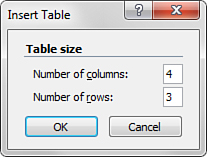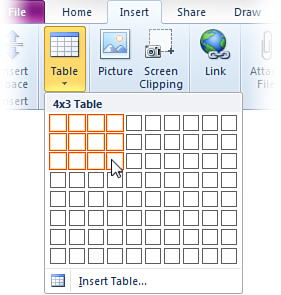Anyone who’s ever used various Microsoft Office
programs like Word, Excel, and PowerPoint to create documents,
spreadsheets, or presentations knows how useful tables can be to organize information and group information together in logical, meaningful ways.
Whether you’re organizing information for yourself
or for other people, you can use tables in OneNote to present data in a
familiar, easy-to-understand, row-and-column format.
Even though OneNote has excellent table support, I
must point out that its approach to table creation and formatting
differs quite a bit from its other Microsoft Office counterparts. As
I’ve mentioned before, such seemingly inconsistent design choices
aren’t the work of programmers who want to drive you crazy. Like many
things in OneNote, it has to do with the complexity of the OneNote
canvas and the freedom it provides from the typical lines and cells
that constrain other types of electronic documents.
Because OneNote is also primarily a tool that lets
you focus on your thoughts and ideas, the creation of tables is much
simpler, compared with other programs. The intent behind this feature
design is for the interface to get out of your way so you can
concentrate on what you’re thinking and writing about.
While even intentional inconsistencies between
computer programs can increase the initial learning curve by a bit, the
payoff comes later, when you’ve learned how to use the feature and you
see how it saves you time. If you prefer to go the long, more
comfortable route when working with tables, OneNote also includes the
“normal” commands on the ribbon to let you create tables on your pages
in more traditional ways.
Creating a Table
To create a table in the most straightforward way, follow these steps:
1. | On any page, click where you want to create a table.
|
2. | On the ribbon, click the Insert tab.
|
3. | In the Tables group, click Table.
|
4. | On the pop-up menu that appears, click the Insert Table command at the bottom of the menu. |
5. | In the small Insert Table dialog box that appears (see Figure 1), enter the number of columns and rows you want to start with and then click OK.

|
If you prefer to visually draw a table grid before filling its cells with information, do the following:
1. | On any page, click where you want to create a table.
|
2. | On the ribbon, click the Insert tab.
|
3. | In the Tables group, click Table.
|
4. | On
the pop-up menu that appears, slowly move the mouse pointer over the
table grid from the upper-left corner toward the lower right until the
text over the table grid indicates the table size. For example, a 4 × 3
table would create a table with 4 columns and 3 rows (see Figure 2).

|
5. | When the text confirms the dimensions you want, click the left mouse button to create the table.
|
Here’s how it works:
1. | On any page, click where you want to create the new table.
|
2. | Start typing the text that you want to appear in the first table cell (the leftmost column and the topmost row).
|
3. | On
your keyboard, press the Tab key. OneNote creates a new table, puts the
text you typed on the current line into the first cell, and then
creates the next column.
|
4. | To
continue the table until it has the dimensions you want, press the Tab
key whenever you want to create a new column or press the Enter key to
create a new row.
|
If the information that you want to include in your
notes already exists in a table format in another program, like the
spreadsheet cells in a Microsoft Excel workbook or a table in a
Microsoft Word document, you can copy any selection from these and
other programs and paste the table or grid selection into your notes.
Note that any tables and spreadsheet cells that you paste into OneNote
might not come over exactly as they appear at their source. OneNote
lacks some of the sophisticated formatting choices that the Quick
Galleries in Word, Excel, and other Office programs offer. This is
because tables in OneNote are primarily intended to organize
information instead of dressing it up with fancy formatting styles for
the purpose of presentation.
If you need to include a fully formatted table in
your notes—the same way it appears in its original spreadsheet or
document—consider taking a screen clipping of the table portion you
want and then inserting it into your notes. Though you can’t edit the
information in screen clippings, this workaround provides a
quick-and-easy way to include related information from other sources in
your notes.
|
After
you have created a table in OneNote, an entire new toolbox of commands
awaits you on the ribbon. To display it, click any cell in your table
to activate the cursor and then look for the yellow Table Tools tab
that appears directly over the Layout tab on the ribbon (see Figure 3).
When you click this yellow tab, 15 table-related commands become
available for you to use. If you work a lot with tables in OneNote, the
extra clicks to reach these commands on the ribbon might become
tedious. For this reason, most of these commands are also available by
right-clicking any cell in a table and then clicking the Table command
on the shortcut menu (only the three cell alignment commands are
exclusive to the Table Tools ribbon tab). I’ll describe each of these
commands in more detail in the following step-by-step procedures.

|